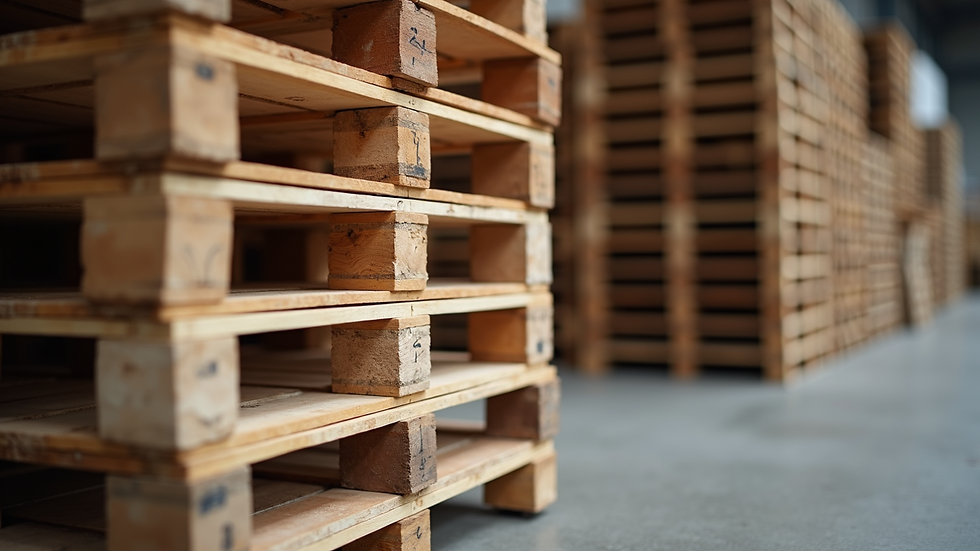Efficiency Boost: Triple Inspection Process for Quality Pallets
- betterpalletcompan
- Aug 10
- 4 min read
In the world of logistics and supply chain management, quality is king. When it comes to pallets, ensuring they meet high standards is crucial. A faulty pallet can lead to damaged goods, increased costs, and unhappy customers. To tackle this issue, many companies are adopting a triple inspection process. This method not only enhances quality but also boosts efficiency. In this post, we will explore how a triple inspection process works and why it is essential for maintaining quality pallets.
Understanding the Importance of Quality Pallets
Quality pallets are the backbone of any supply chain. They support the safe transport of goods, ensuring that products arrive at their destination in perfect condition. Poor-quality pallets can lead to:
Product Damage: Weak or broken pallets can cause items to fall or shift during transport.
Increased Costs: Replacing damaged goods and pallets can be expensive.
Customer Dissatisfaction: Delivering damaged products can harm a company's reputation.
By focusing on quality, businesses can avoid these pitfalls and create a more efficient operation.
The Triple Inspection Process Explained
The triple inspection process involves three distinct stages of quality checks. Each stage is designed to catch potential issues before they escalate. Here’s a breakdown of the process:
1. Initial Inspection
The first step in the triple inspection process is the initial inspection. This occurs as soon as the pallets are received from the manufacturer. During this stage, the following checks are performed:
Visual Inspection: Inspectors look for visible defects such as cracks, splinters, or warping.
Dimensional Checks: Pallets are measured to ensure they meet standard sizes.
Material Quality: Inspectors assess the wood or plastic material for durability.
This initial inspection helps to filter out any pallets that do not meet the required standards right from the start.
2. Functional Testing
Once the initial inspection is complete, the next step is functional testing. This stage evaluates how well the pallets perform under load. Key aspects of functional testing include:
Load Capacity Testing: Pallets are tested to ensure they can hold the specified weight without failure.
Stability Tests: Inspectors check if the pallets remain stable when loaded.
Stacking Tests: This ensures that pallets can be safely stacked without collapsing.
Functional testing is crucial for ensuring that pallets can handle the demands of transportation and storage.
3. Final Quality Assurance
The final stage of the triple inspection process is the quality assurance check. This is a comprehensive review that includes:
Re-inspection of Rejected Pallets: Any pallets that were flagged during the initial inspection are re-evaluated after repairs.
Documentation Review: Inspectors verify that all necessary documentation is in order, including compliance with safety standards.
Final Approval: Only pallets that pass this stage are approved for use.
This thorough final check ensures that only the highest quality pallets make it into the supply chain.
Benefits of the Triple Inspection Process
Implementing a triple inspection process offers numerous benefits for businesses. Here are some of the key advantages:
Enhanced Quality Control
With three layers of inspection, the likelihood of defective pallets slipping through the cracks is significantly reduced. This leads to higher overall quality in the supply chain.
Increased Efficiency
By catching issues early, companies can avoid costly delays and disruptions. This streamlined process allows for faster turnaround times and improved productivity.
Cost Savings
Investing in a triple inspection process can lead to long-term savings. Fewer damaged goods mean lower replacement costs and less waste.
Improved Customer Satisfaction
Delivering high-quality pallets leads to better customer experiences. Satisfied customers are more likely to return and recommend your services to others.
Real-World Examples
Many companies have successfully implemented a triple inspection process to enhance their pallet quality. Here are a couple of examples:
Example 1: A Major Retailer
A large retail chain faced issues with damaged goods due to poor-quality pallets. They adopted a triple inspection process, which included rigorous checks at each stage. As a result, they saw a 30% reduction in product damage and a significant increase in customer satisfaction.
Example 2: A Logistics Company
A logistics company specializing in food transport implemented the triple inspection process to ensure the safety of their products. By conducting thorough inspections, they improved their compliance with safety regulations and reduced their liability risks.
Tips for Implementing a Triple Inspection Process
If you are considering adopting a triple inspection process for your pallets, here are some practical tips:
Train Your Staff
Ensure that your team is well-trained in the inspection process. Provide them with the necessary tools and knowledge to perform thorough checks.
Use Technology
Consider using technology to streamline the inspection process. Digital checklists and tracking systems can help maintain consistency and accuracy.
Regularly Review Your Process
Continuously evaluate your inspection process to identify areas for improvement. Regular reviews can help you adapt to changing industry standards and customer needs.
The Future of Pallet Quality Control
As the logistics industry evolves, so too will the methods for ensuring pallet quality. The triple inspection process is just one example of how companies are adapting to meet the demands of modern supply chains.
Embracing Automation
In the future, we may see more automation in the inspection process. Automated systems can quickly identify defects and streamline the quality assurance process.
Sustainability Considerations
With a growing focus on sustainability, companies may also look for eco-friendly materials and practices in their pallet production and inspection processes.
Wrapping It Up
The triple inspection process is a game-changer for businesses that rely on quality pallets. By implementing this method, companies can enhance quality control, increase efficiency, and ultimately improve customer satisfaction.
Investing in a robust inspection process is not just about meeting standards; it is about building a reputation for reliability and excellence. As the logistics landscape continues to evolve, those who prioritize quality will stand out in a competitive market.

By focusing on quality and efficiency, businesses can ensure that they are well-equipped to meet the challenges of the future.


Comments